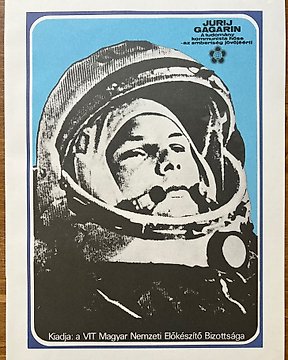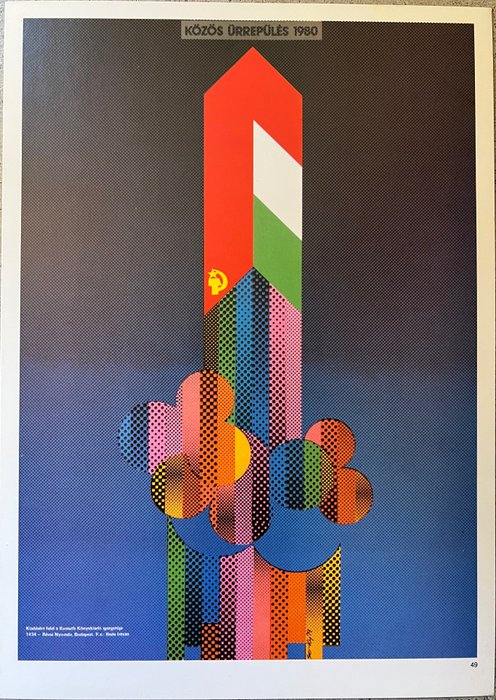
Gabor Gyarfas - 1973 Jurij Gagarin - NASA - space - Budapest - Hungary - Russian - USSR, - Années 1970
Nº 78310281

Nº 78310281

Official offset reprint on thick paper of the original one
Iconic poster about Russian space programme
Shipping is with insurance
So-Ky background:
An artist couple who have been working together since the beginning of the 1950’s, they were highly effective and convinced propagandists for the socialist system. In addition to political posters, they worked in every field of visual communication.
Their posters represent the typical visual culture of the 1960’s, illustrating a style known today as “retro” or socialist modernism that defined the furniture, architecture, and graphic design of the period. After the decline of mandatory socialist realism, a new trend became influential. It combined typical socialist subjects (the life of workers, factories, family, agriculture) with a modern attitude and style: they have used a style close to constructivism. This tendency, now called soc-modern, became significant in the eastern bloc in the 1960s. So-Ky used several techniques, like paper cut, drawing, photo, photomontage and they often have used only clear typographic design. For their political posters they use simple but effective forms and symbols, sometimes without any text. For example, the red sickle and hammer and ripped barbed wire stand together for the “liberation” of 1945.
Long deacription:
Éva Kemény graduated in textile design from the College of Applied Arts in 1949, where her mentors were Pál Miháltz and Béla Molnár. She met her husband, László Sós, a fellow artist who started his career in István Irsai's workshop, in the early forties. They first presented a joint artwork at the 1956 national poster exhibition, already using the artistic name SO-KY. This work caught the attention of the United Bulb Company (Egyesült Izzó), leading to a lasting collaboration with the artist duo. Among their numerous works designed for the company, the most notable is the creation of the visual identity still used by Tungsram. They also worked for many other major companies, designing product and cultural posters for CASCO, IBUSZ, and BNV, but their most significant activity became the design of political posters.
Sós and Kemény never concealed their political beliefs, as art historian Nóra Aradi puts it, "embracing ideological and material responsibility and risk." In the fifties, they were not yet involved in political poster design. They received their first commission in this direction in 1967 when the avant-garde style they represented had already integrated well into the cultural policy of the Kádár era. The artist duo's committed left-wing stance and their pacifism stemming from their experiences during the war, coupled with a strong anti-American sentiment in the sixties, became a defining factor in the domestic graphic arts scene. This was mainly due to their numerous traveling exhibitions with an educational purpose.
Since official commissions were relatively rare and mostly limited to holidays, anniversaries, congresses, and party events, SO-KY often created political posters with their own content and messages. In addition to the customary posters celebrating anniversaries such as April 4th, May 1st, August 20th, November 7th, International Women's Day, Mother's Day, and Children's Day, they were instrumental in spreading the genre of peace posters in Hungary. Their highly imaginative and impactful propaganda arsenal included strong visual contrasts (contrasting symbols of the developed Western world with starving African children), meaningful visual elements (the CIA snake coiled around the tree of independent countries, or the peace dove dressed in the American flag and shot through the heart), as well as effective typography (forming the letters "NATO" into a cross).
SO-KY achieved significant results not only in poster design but also in the field of logo design. Their emblems, bearing elements of pop and op-art, generally served as occasional printed decorations, but some were particularly successful and entered commercial circulation. In addition to the aforementioned Tungsram visual identity, they created logos for Budapest FÜSZÉRT Company, Képcsarnok, Csepel School Gallery, Művészeti Alap, Luxus Department Store, and Hotel Karancs in Salgótarján. One of their most beautiful works was the 1975 KGST emblem, where an effective and elegant decoration was formed by a swirling black pattern within three arcs, centered around an unusually small five-pointed star.
SO-KY's work was also crucial in exhibition design, an area of advertising graphics that is less explored and researched. They were entrusted with prestigious projects such as the "60 Years of the Soviet Union" exhibition, which was produced in fifty copies and presented in 14 countries, the "25 Years of the Workers' Guard," or the major Bartók exhibition presented in three Tunisian cities in 1970. They also designed the permanent exhibition of the Hungarian Labor Movement Museum, which opened in 1979 in the former Royal Palace in Buda.
—
About Hungarian Poster Art
Hungarian poster art has long been celebrated for its unique and captivating style, making it a significant cultural and artistic movement in the world. From the late 19th century to the present day, Hungarian poster art has left an indelible mark on the global art scene, with its innovative techniques, bold designs, and powerful messages.
One of the highlights of Hungarian poster art is its ability to seamlessly blend various artistic styles and influences. The movement drew inspiration from a wide range of sources, including Art Nouveau, Constructivism, and Surrealism, resulting in a diverse and eclectic body of work. Artists such as Mihály Bíró, József Bottlik, and István Irsai pushed the boundaries of traditional poster design, experimenting with typography, color, and composition to create visually striking and thought-provoking pieces.
Another notable aspect of Hungarian poster art is its emphasis on storytelling and narrative. Unlike many other countries' posters, which primarily served as advertising tools, Hungarian posters often conveyed a deeper meaning or social commentary. They were not just meant to sell products but also to engage viewers intellectually and emotionally. This storytelling approach allowed Hungarian poster art to transcend its commercial purpose and become a powerful medium for social and political expression.
The importance of Hungarian poster art in the world cannot be overstated. During the early 20th century, Hungary was at the forefront of graphic design, and its posters gained international recognition and acclaim. The Budapest School, a group of Hungarian artists, revolutionized the field with their avant-garde approach, influencing poster art movements across Europe and beyond. Their innovative techniques and artistic vision set new standards for poster design, inspiring generations of artists worldwide.
Furthermore, Hungarian poster art played a crucial role in shaping public opinion and mobilizing society. In times of political turmoil and social change, posters became a powerful tool for propaganda and activism. During World War II and the Hungarian Revolution of 1956, posters were used to rally support, convey messages of resistance, and document historical events. The ability of Hungarian artists to capture the spirit of the times and communicate complex ideas through visual imagery made their posters an integral part of the nation's cultural and political identity.
Today, Hungarian poster art continues to thrive, with contemporary artists carrying on the legacy of their predecessors. The Hungarian Poster Museum in Budapest showcases the rich history and evolution of this art form, attracting visitors from around the world. The enduring appeal and influence of Hungarian poster art can be seen in the works of renowned artists like Tibor Helényi and István Orosz, who have successfully merged traditional techniques with modern aesthetics.
In conclusion, Hungarian poster art stands as a testament to the country's artistic prowess and cultural heritage. Its unique style, emphasis on storytelling, and ability to provoke thought and emotion have made it an important and influential movement in the world. From its early beginnings to the present day, Hungarian poster art continues to captivate audiences and inspire artists, leaving an indelible mark on the global art scene.
Comment acheter sur Catawiki ?
1. Découvrez des objets d’exception
2. Faites la meilleure offre
3. Effectuez un paiement sécurisé